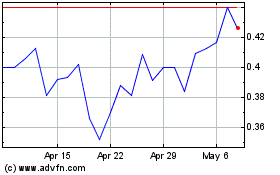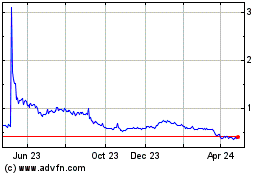Trevena, Inc. (Nasdaq: TRVN), a biopharmaceutical company focused
on the development and commercialization of novel medicines for
patients with central nervous system (CNS) disorders, announced
today preclinical data from two separate research collaborations.
The first from a series of experiments conducted in collaboration
with scientists at Virginia Commonwealth University and presented
at the recent annual meeting of the American Society for
Pharmacology and Experimental Therapeutics in May 2024. These
studies examined the cellular mechanism of analgesic effects of
TRV045, a novel S1P1 receptor modulator, in a mouse model of
chemotherapy-induced peripheral neuropathy (CIPN). The second set
of studies was from a separate, ongoing collaboration, with the
NIH-supported Epilepsy Therapy Screening Program (ETSP) which
studied the use of TRV045 in three different preclinical models
examining its potential effects on acute seizure protection and its
potential ability to modify seizure development, or
epileptogenesis.
Data in Preclinical Neuropathic Pain Model
“TRV045 showed clear and sustained analgesic-like properties in
animal models of neuropathic pain, while showing no evidence of
peripheral lymphopenia,” said Dana Selley, PhD, Professor of
Pharmacology and Toxicology at Virginia Commonwealth University.
“Our studies provide molecular insights into these actions and
demonstrate that TRV045 behaves differently from current S1P
modulators such as fingolimod at the S1P1 receptor in CNS pain
processing centers, where TRV045 caused neither desensitization of
receptor function nor downregulation of receptor
protein. These data suggest that TRV045 exerts its efficacy
through agonist signaling.”
This newly reported preclinical data, presented as a poster at
the recent annual meeting of the American Society for Pharmacology
and Experimental Therapeutics in May 2024, provides further insight
into TRV045’s mechanism of action and its potential as a
differentiated long-term therapeutic for neuropathic pain. In this
study, TRV045 did not cause S1P1R functional desensitization or
S1PR1 protein reduction despite repeated dosing over 14 days. In
contrast, fingolimod, an approved S1PR modulator, demonstrated both
significant S1P1R functional desensitization and protein reduction
in this same model. As a result, the Company believes TRV045 may
represent a differentiated mechanism to provide sustained S1P1R
agonism and analgesic effect, unlike other S1PR modulators, such as
fingolimod, that demonstrate initial agonism but long-term
functional antagonism due to S1PR desensitization and protein
reduction.
In this new study, S1PR1 functional desensitization was measured
by S1PR1 stimulated 35SGTPgS binding in membrane homogenates of
spinal cord prepared from drug treated mice. Repeated fingolimod (1
mg/kg, once a day for 14 days) dosing decreased such 35SGTPgS
binding by approximately 70% compared with vehicle, while repeated
TRV045 oral dosing (10 mg/kg, once a day for 14 days) had no
effect. S1PR1 protein expression measured by Western immunoblotting
indicated that repeated fingolimod treatment caused an
approximately 30% reduction in S1P1R protein in spinal cord while
repeated TRV045 treatment had no effect. Similar effects were seen
in the region of the periaqueductal gray; both of these regions
play important roles in pain transmission. We believe these studies
indicate that, unlike fingolimod, TRV045 does not cause S1PR1
protein reduction or S1PR1 functional desensitization, suggesting
that sustained TRV045 agonism is the underlying mechanism for its
analgesic effects.
Trevena has previously reported that, in a validated mouse model
of CIPN, oral administration of TRV045 (1 mg/kg, 3 mg/kg, and 10
mg/kg) reduced mechanical and cold stimulus-evoked nociception in a
statistically significant, dose-related manner (at the 3 mg/kg and
10 mg/kg doses only). These effects were present after acute single
dose administration of TRV045 in both male and female mice and
after repeated treatment (once daily for 7 days).
Trevena has previously observed that TRV045, unlike other known
S1P-targeted compounds, exerted these analgesic effects in the
absence of any reduction in circulating peripheral lymphocytes,
suggesting that TRV045’s analgesic effects may not be due to
receptor down-regulation.
Data in Preclinical Epilepsy Models
“The data observed with TRV045 in the ETSP study program showed
a clear and strong anticonvulsant effect across a range of animal
models. Current pharmacotherapy options in epilepsy are limited by
incomplete anti-seizure medication efficacy and tolerance”, said
Alexander Rotenberg, MD, PhD, Professor of Neurology at Boston
Children’s Hospital and Harvard Medical School. “With its unique
mechanism of action, TRV045 has the potential to open an important
new approach to epilepsy treatment.”
In a preclinical study using a validated model of seizure
induction in mice, known as the intravenous Pentylenetetrazol
(ivPTZ) Seizure Threshold Test, one of four doses of TRV045 (5, 10,
20 or 30mg/kg) or vehicle was orally administered to ten mice per
dosage level. At one hour after test drug administration, 0.5% PTZ
solution, a known seizure-inducing compound, was administered via
iv infusion. Outcome measures included time to the first myoclonic
(whole-body) twitch, and time to generalized clonus (seizure).
At the 30mg/kg dose, TRV045 demonstrated a statistically
significant increase in time to first myoclonic twitch (31.6
seconds TRV045 vs 26.0 seconds vehicle, p=0.02). This dose of
TRV045 also demonstrated an increase in time to generalized clonus
(33.9 seconds TRV045, vs 28.7 seconds vehicle, p=0.056).
A separate study used a validated model of acute anti-seizure
effect in rats, the maximal electroshock (MES) model. In this test,
60 Hz of alternating current (150 mA) is delivered for 0.2 sec by
corneal electrodes after application of local anesthesia.
Protection from MES-induced seizures is shown by abolition of the
hindlimb tonic extensor component of the seizure episode. Rats (N=8
per group) were tested at four doses of TRV045, administered by
intra-peritoneal (IP) injection (10, 15, 20 and 30 mg/kg). There
was a dose-dependent protection observed across the dose range,
reaching 7 of 8 rats protected at the 30 mg/kg dose level, and an
estimated effective dose for 50% of the population (ED50) of 18
mg/kg.
Finally, TRV045 was screened in a preliminary study to evaluate
the potential for TRV045 to exert an antiepileptogenic effect, or
to prevent the emergence of epilepsy. In this model, rats underwent
repeated low-dose IP injection of kainic acid to induce status
epilepticus (SE), which leads to the development of spontaneous
recurring seizures weeks later. Administration of test compounds
immediately after the induction of SE, and before the development
of spontaneous seizures, provides insight into the potential
disruption of the process of seizure development, or
epileptogenesis. One hour after SE induction, 24 rats were
randomized into two equal sized groups and injected with a dose of
either TRV045 (15 mg/kg, IP) or vehicle solution three times per
day for 7 days. All animals were then surgically fitted with EEG
monitoring devices to assess later spontaneous seizure activity
through automated assessment. At two time intervals, weeks 4-6 and
weeks 8-10 following induction of SE, seizure activity was then
measured. At the latest time interval, weeks 8-10, two animals in
the TRV045 group (17%) were seizure free, while no animals in the
vehicle group reached this endpoint. However, there was no
statistically significant difference in the outcomes of seizure
frequency, seizure burden or seizure severity between TRV045 and
vehicle treated groups at either observation interval.
Taken together, the results of these studies are consistent with
prior data indicating that TRV045 showed an anti-seizure effect in
validated animal models of pharmaco-resistant epilepsy. Based on
these data, the ETSP plans to initiate additional studies of the
anti-seizure potential of TRV045. Although the initial assessment
of the potential anti-epileptogenic effect of TRV045 did not
demonstrate a statistically significant difference on the outcomes
studied here, these results will assist in subsequent
considerations of other dose and treatment duration in future
seizure prevention studies.
About Trevena
Trevena, Inc. is a biopharmaceutical company focused on the
development and commercialization of innovative medicines for
patients with CNS disorders. The Company has one approved product
in the United States, OLINVYK® (oliceridine) injection,
indicated in adults for the management of acute pain severe enough
to require an intravenous opioid analgesic and for whom alternative
treatments are inadequate. The Company’s novel pipeline is based on
Nobel Prize winning research and includes three differentiated
investigational drug candidates: TRV045 for diabetic neuropathic
pain and epilepsy, TRV250 for the acute treatment of migraine and
TRV734 for maintenance treatment of opioid use disorder.
For more information, please
visit www.Trevena.com
About TRV045
TRV045 is a novel, highly selective
sphingosine-1-phosphate subtype 1 (S1P1) receptor modulator being
developed as a potential treatment for acute and chronic
neuropathic pain secondary to diabetic peripheral neuropathy.
Through a collaboration with the National Institutes of Health,
Trevena is also exploring TRV045 as a potential treatment for
epilepsy.
S1P receptors are located throughout the body,
including the central nervous system, where they are believed to
play a role in modulating neurotransmission and membrane
excitability.
Trevena's discovery efforts have identified a
family of compounds that are highly selective for the S1P1
receptor. TRV045 reversed thermal hyperalgesia, a measure of
neuropathic pain, in nonclinical models of diabetic peripheral
neuropathy and chemotherapy-induced peripheral neuropathy. TRV045
was not associated with lymphopenia and produced no changes in
blood pressure, heart rate, or respiratory function at or above
pharmacologically active doses in nonclinical studies. TRV045 is an
investigational product and is not yet approved by the FDA.
Forward-Looking Statements
Any statements in this press release about
future expectations, plans and prospects for the Company, including
statements about the Company’s strategy, future operations,
clinical development and trials of its therapeutic candidates,
plans for potential future product candidates and other statements
containing the words “anticipate,” “believe,” “estimate,” “expect,”
“intend,” “may,” “plan,” “predict,” “project,” “suggest,” “target,”
“potential,” “will,” “would,” “could,” “should,” “continue,” and
similar expressions, constitute forward-looking statements within
the meaning of The Private Securities Litigation Reform Act of
1995. Actual results may differ materially from those indicated by
such forward-looking statements as a result of various important
factors, including: the expectations surrounding the continued
advancement of the Company’s product pipeline; the potential safety
and efficacy of the Company’s product candidates and their
regulatory and clinical development; the Company’s intention to
pursue strategic alternatives for OLINVYK and the ability of any
such strategic alternative to provide shareholder value; the
expected financial and operational impacts of the Company’s
decision to reduce commercial support for OLINVYK; the status,
timing, costs, results and interpretation of the Company’s clinical
trials or any future trials of any of the Company’s investigational
drug candidates; the uncertainties inherent in conducting clinical
trials; expectations for regulatory interactions, submissions and
approvals, including the Company’s assessment of discussions with
FDA; available funding; uncertainties related to the Company’s
intellectual property; uncertainties related to other matters that
could affect the availability or commercial potential of the
Company’s therapeutic candidates and approved product; and other
factors discussed in the Risk Factors set forth in the Company’s
Annual Report on Form 10-K and Quarterly Reports on Form 10-Q filed
with the Securities and Exchange Commission (SEC) and in other
filings the Company makes with the SEC from time to time. In
addition, the forward-looking statements included in this press
release represent the Company’s views only as of the date hereof.
The Company anticipates that subsequent events and developments may
cause the Company’s views to change. However, while the Company may
elect to update these forward-looking statements at some point in
the future, it specifically disclaims any obligation to do so,
except as may be required by law.
For more information, please
contact:
Company Contact:Bob YoderSVP
and Chief Business OfficerTrevena, Inc.(610) 354-8840
Trevena (NASDAQ:TRVN)
Historical Stock Chart
From Dec 2024 to Jan 2025

Trevena (NASDAQ:TRVN)
Historical Stock Chart
From Jan 2024 to Jan 2025
